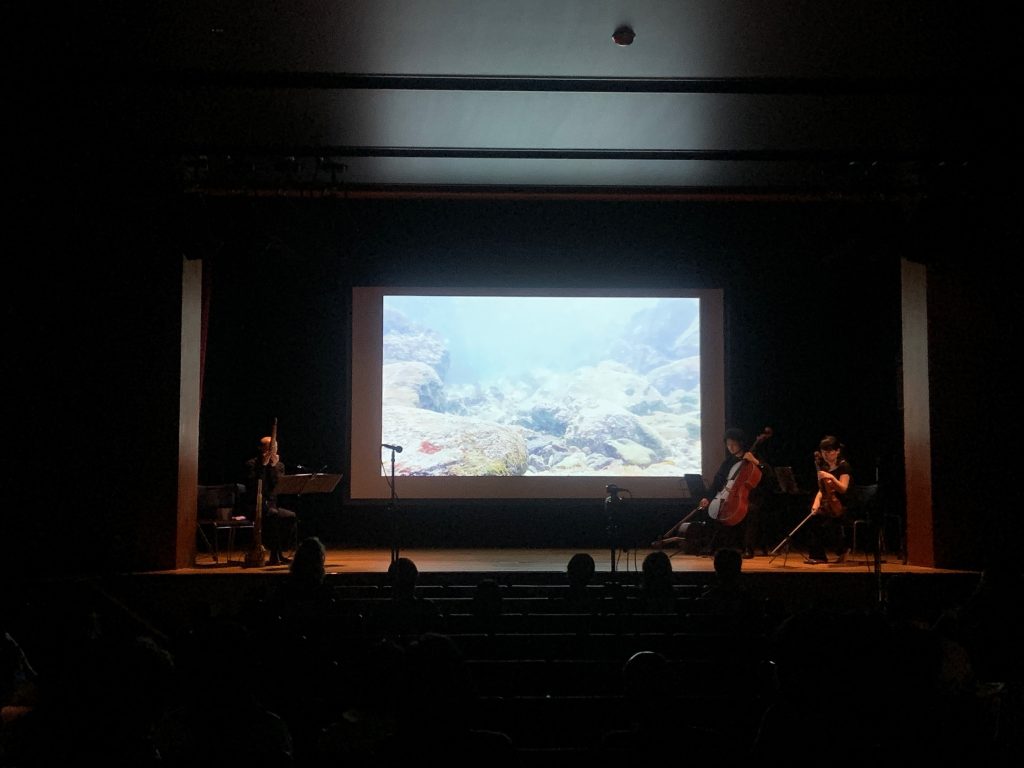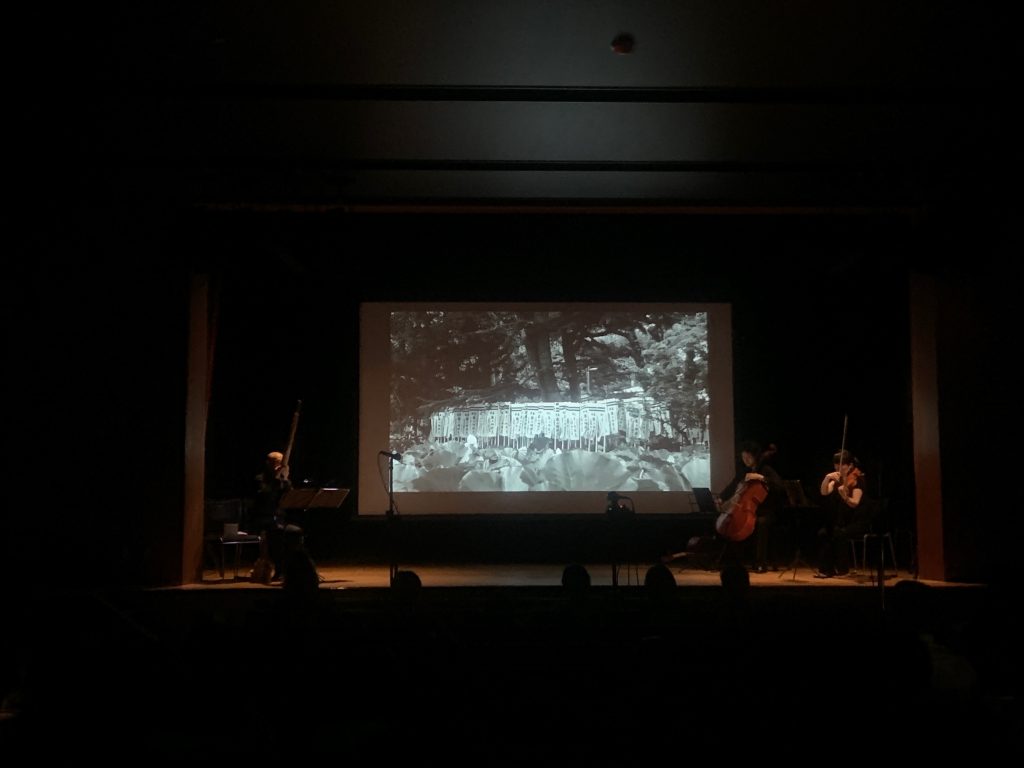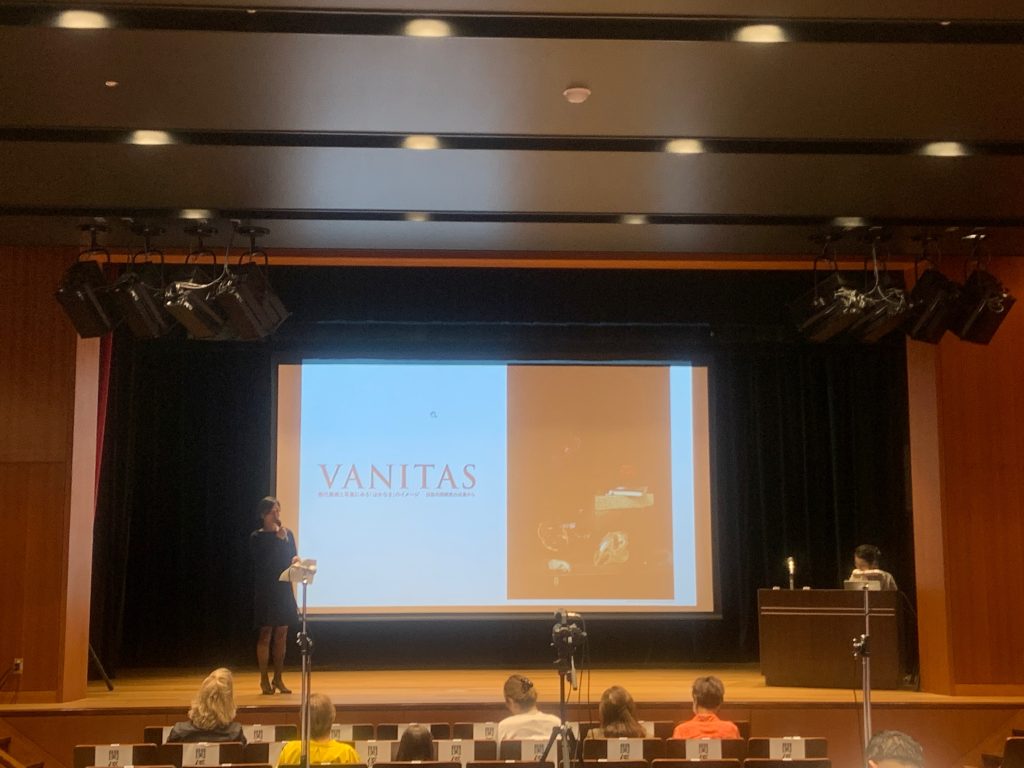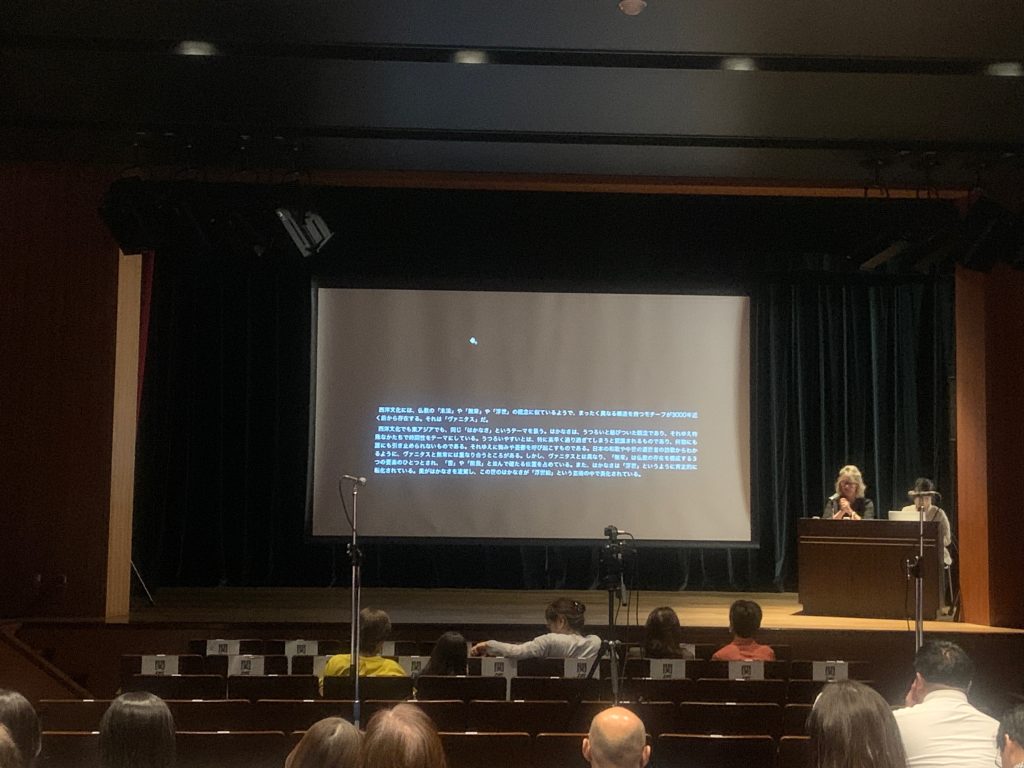
On September 29th, VANITAS was performed at the Fukuoka City Museum. Flyers of VANITAS were frequently seen on the Ohashi campus because the music for the performance was composed and directed by Assistant Professor Daryl Jamieson, who belongs to the Acoustic Design course. The performance was included contemporary art, images, and music, which together formed a type of musical theatre.
As seen in the attached pictures, there were three musicians on the stage. The person on the left played the shō and u (traditional Japanese free-reed mouth organs), the person on the right played the viola, and the person on the far right played the cello. These musicians expressed the theme of “VANITAS” through their performance of Professor Jamieson’s compositions. The violist often plucked the strings, while the cellist produced sounds reminiscent of door pulls. The images displayed during the music included scenes Shintō, rivers, inside a sea, etc. Most of these images were in monochrome to convey the sense of transience.
After this performance, Professor Dr. Victoria von Flemming from the Braunschweig University of Art in Germany explained the concept of “VANITAS” in German, with simultaneous translation into Japanese. Do you know the meaning of “VANITAS”? It is a Latin word that signifies emptiness and transience. In the performance, transience was conveyed through sounds, as sound naturally fades away.
In the history of Western culture, there is no positive image associated with transience. Those who used the VANITAS motif tried to connect transience with feelings of helplessness, hopelessness, or resignation. The source or the motif is from the Old Testament. It suggests that it is God’s will and plan for the present to repeat the past and the future to be a mere repetition of the present. However, there is an implication that there is a right time for everything. When it is possible to recognize that moment, VANITAS seems to contain at least a tiny bit of positive value.
Anxiety about death is no longer fueled by a division of faith but by a decline of religiosity, confidence in salvation and truth, and a recognition of the limits of progress. In modern times, infectious diseases such as AIDS, cancer, and new coronaviruses demonstrate the limits of medicine. The model of reason-based, progress-oriented life that began at the beginning of the Enlightenment has failed, and we are witnessing the ruins of this model.
Transience, at the core of the Western model of progress and life, promises the longest and happiest life possible. But it is an empty promise that will burst like a soap bubble. This reflects not only transience but also the futility and meaninglessness of human life.
I hope through this article, you can learn a little more about the art of VANITAS.
About the writer
Kana Kusumi
I am a master’s first-year student in the Acoustic Design Course at the Graduate School of Design. I am learning English and Danish to study abroad in Denmark after graduation. Since becoming a Geiko student supporter, I enjoy interacting with various international students. If you have any problems with the language, please let me know! I can help to translate or be your interpreter!
As seen in the attached pictures, there were three musicians on the stage. The person on the left played the shō and u (traditional Japanese free-reed mouth organs), the person on the right played the viola, and the person on the far right played the cello. These musicians expressed the theme of “VANITAS” through their performance of Professor Jamieson’s compositions. The violist often plucked the strings, while the cellist produced sounds reminiscent of door pulls. The images displayed during the music included scenes Shintō, rivers, inside a sea, etc. Most of these images were in monochrome to convey the sense of transience.
After this performance, Professor Dr. Victoria von Flemming from the Braunschweig University of Art in Germany explained the concept of “VANITAS” in German, with simultaneous translation into Japanese. Do you know the meaning of “VANITAS”? It is a Latin word that signifies emptiness and transience. In the performance, transience was conveyed through sounds, as sound naturally fades away.
In the history of Western culture, there is no positive image associated with transience. Those who used the VANITAS motif tried to connect transience with feelings of helplessness, hopelessness, or resignation. The source or the motif is from the Old Testament. It suggests that it is God’s will and plan for the present to repeat the past and the future to be a mere repetition of the present. However, there is an implication that there is a right time for everything. When it is possible to recognize that moment, VANITAS seems to contain at least a tiny bit of positive value.
Anxiety about death is no longer fueled by a division of faith but by a decline of religiosity, confidence in salvation and truth, and a recognition of the limits of progress. In modern times, infectious diseases such as AIDS, cancer, and new coronaviruses demonstrate the limits of medicine. The model of reason-based, progress-oriented life that began at the beginning of the Enlightenment has failed, and we are witnessing the ruins of this model.
Transience, at the core of the Western model of progress and life, promises the longest and happiest life possible. But it is an empty promise that will burst like a soap bubble. This reflects not only transience but also the futility and meaninglessness of human life.
I hope through this article, you can learn a little more about the art of VANITAS.
About the writer
Kana Kusumi
I am a master’s first-year student in the Acoustic Design Course at the Graduate School of Design. I am learning English and Danish to study abroad in Denmark after graduation. Since becoming a Geiko student supporter, I enjoy interacting with various international students. If you have any problems with the language, please let me know! I can help to translate or be your interpreter!







